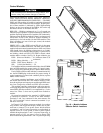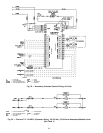
Control Modules
Turn controller power off before servicing controls. This
ensures safety and prevents damage to controller.
PROCESSOR MODULE (PSIO), 4 IN/4 OUT MODULE
(SIO), LOW-VOLTAGE RELAY MODULE (DSIO-LV),
AND EXV DRIVER MODULE (DSIO-EXV) — The PSIO,
DSIO and SIO modules all perform continuous diagnostic
evaluations of the condition of the hardware. Proper opera-
tion of these modules is indicated by LEDs (light-emitting
diodes) on the front surface of the DSIOs, and on the top
horizontal surface of the PSIO and SIO.
RED LED — Blinking continuously at a 3- to 5-second rate
indicates proper operation. Lighted continuously indicates a
problem requiring replacement of module. Off continuously
indicates power should be checked. If there is no input power,
check fuses. If fuse is bad, check for shorted secondary of
transformer or for bad module. On the PSIO module, if the
light is blinking at a rate of twice per second, the module
should be replaced.
GREEN LED — On a PSIO and an SIO, this is the green
LED closest to COMM connectors. The other green LED on
module indicates external communications, when used. Green
LED should always be blinking when power is on. It indi-
cates modules are communicating properly. If green LED is
not blinking, check red LED. If red LED is normal, check
module address switches. See Fig. 18. Proper addresses are:
PSIO (Processor Module) — 01 (different when CCN
connected)
DSIO (Relay Module) — 19
DSIO (EXV Driver Module) — 31
SIO (4 In/4 Out Module) — 59
If all modules indicate communication failure, check COMM
plug on PSIO module for proper seating. If a good connec-
tion is assured and condition persists, replace PSIO module.
If only DSIO or SIO module indicates communication fail-
ure, check COMM plug on that mode for proper seating. If
a good connection is assured and condition persists, replace
DSIO or SIO module.
All system operating intelligence rests in PSIO module,
the module that controls unit. This module monitors condi-
tions through input and output ports and through DSIO mod-
ules (low-voltage relay module and EXV driver module).
The machine operator communicates with microproces-
sor through keypad and display module. Communication be-
tween PSIO and other modules is accomplished by a 3-wire
sensor bus. These 3 wires run in parallel from module to
module.
On sensor bus terminal strips, terminal 1 of PSIO module
is connected to terminal 1 of each of the other modules.
Terminals 2 and 3 are connected in the same manner. See
Fig. 19. If a terminal 2 wire is connected to terminal 1, sys-
tem does not work.
In Flotronic™ II chillers, processor module, low-voltage
relay module, and keypad and display module are all pow-
ered from a common 21-vac power source which connects
to terminals 1 and 2 of power input strip on each module. A
separate source of 21-vac power is used to power options
module through terminals 1 and 2 on power input strip. A
separate source of 12.5 vac power is used to power EXV
driver module through terminals 1 and 2 on power input strip.
Fig. 18 — Module Address
Selector Switch Locations
63


















